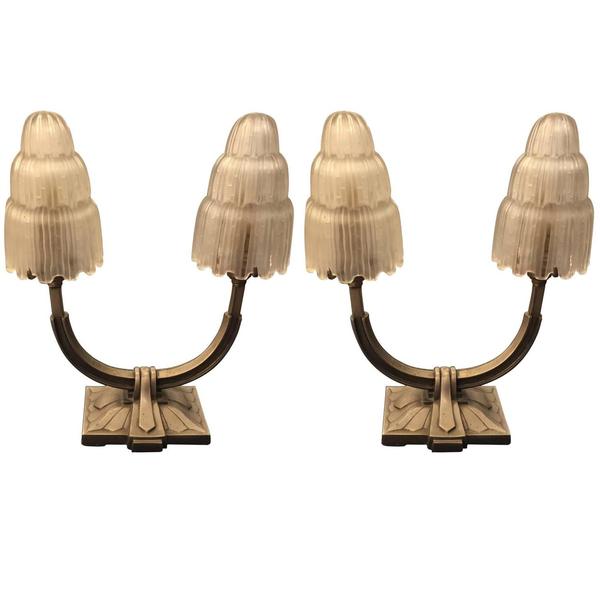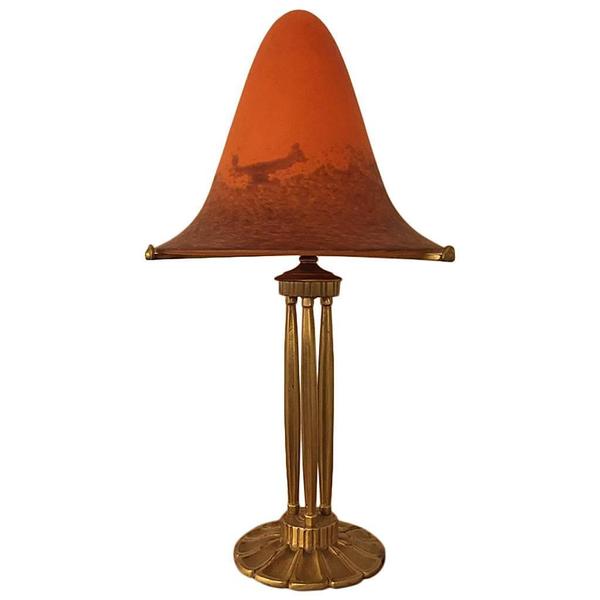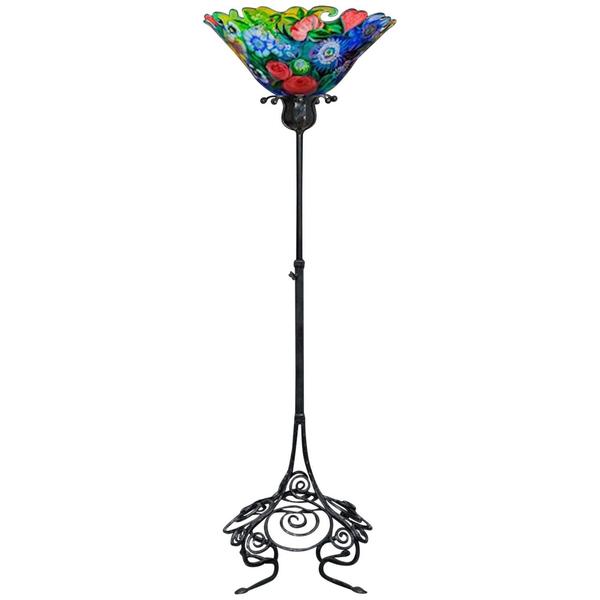Keep Your Lights Shining Bright 0
A 1-2-3 guide to cleaning and caring for Art Deco chandeliers, light fittings and lamps
Bronze
So you've finally chosen and installed your Art Deco lighting. You're surrounded by the soft, gentle glow of sconces, ceiling lights and table lamps that reflect your love for this fantastic decor art form.
But, like everything else, they will get dusty and dirty over time and cleaning them may take a little more care than ordinary light fittings. This step-by-step guide will help you take care of your lights and keep them shining.
Step 1: Know your materials
Glass and Silvered Bronze
Art Deco as a design form drew its influences from all over the world and, as a result, its materials came from every conceivable available source - glass, metal, wood, bone, ceramics and fabric could all quite happily coexist in one piece.
One thing you won't find a lot of in genuine Art Deco is plastic, as most polymers only came into use after World War II, but you may find one or two pieces made of Bakelite.
When buying cleaning products to use on your Art Deco pieces, make sure you are buying the appropriate products - pewter cleaner is no good for wood, while wood polish could wreck your beautiful hand-painted glass shade.
If in doubt, ask the seller or an antiques expert to help you identify the various materials.
Step 2: Careful cleaning
Glass and Copper
The easiest way to keep your lights clean is to dust them regularly. Using a soft cloth, wipe them down gently. Don't use a duster, because all the dust will just fly into the air to settle back on the fittings minutes later.
Even with regular dusting, you will still need to occasionally give your pieces a thorough cleaning. Once every six months to once a year should do it, unless you live in a particularly dusty or smoggy area.
Before washing any part of your lamp, such as the glass, crystal or ceramic parts, check it thoroughly for cracks, chips or other damage - especially in the glaze on ceramics. It is very difficult to get such cracks properly dry and this could cause all kinds of further damage.
Make sure you spend some time gently cleaning all the corners, crevices and nooks where grime can accumulate. Use soft cloths, q-tips or very soft-bristled brushes.
Double-check whether wooden parts are varnished or raw. They may need oil rather than polish. If you use oil, stick with oil; if you use wax, stick with wax. Don't switch between the two, as this can cause cloudiness and build-ups.
Step 3: Don't DIY
Painted Glass and Hand-Forged Iron
When the time comes to take down your enormous crystal and pewter chandelier to individually clean all 500 pieces, or when your hand-painted one-of-a-kind sconces are looking a bit dull and you want to give them a wash, don't.
The same goes for those ceramic pieces with the cracked glaze we talked about earlier, or the carved bone filigree piece with thousands of pin-prick holes.
When it comes to the more specialized pieces, if you have even an ounce of doubt, it's better to leave it to the professionals. Genuine Art Deco pieces are usually quite pricey and unique, so it's worthwhile knowing one or two expert cleaning services to help you.
Make sure they really know the style and don't be afraid to ask them for references - and to contact the references! And also feel free to ask them about maintenance between the annual big clean. They will offer the best and most accurate advice.
- Matthew Pillet
- Tags: art deco ceiling light chandelier cleaning french art deco interior design lamp lighting painted glass sconce stained glass
A Brief History of Art Deco Chandeliers 0

Art Deco is certainly a style on its own, one that stands out among the various styles of the twentieth century and one that persists as a viable decor option even today.
In the same way, chandeliers are a decor and design item all to themselves. Any home can certainly have perfectly adequate and even beautiful lighting without one, but a chandelier brings a unique touch of style to a room, anchoring its decor in a way no other item can.
From simple to ornate...

When they made their appearance in medieval times, chandeliers were simple wooden crosses to which candles could be affixed and which could be transported from room to room.
Over time and as artisans developed new techniques in metal work, glass blowing, crystal cutting, chandeliers became more ornate, larger and more intricate. Of course, this also meant they became more expensive and therefore only afforded by the rich, or appearing in larger churches and cathedrals.
Chandeliers quickly became synonymous with wealth and status, something to aspire to. Stately homes' ceilings would virtually groan under the weight of glass, crystal, metal and candles and later gas-fired and eventually electric chandeliers.
... and back again

Right up until the early twentieth century, this was the status quo... and then came along our favorite decor movement which, naturally, turned everything on its head.
Yes, the ornate and stately chandeliers found new life in Art Deco styles, but simpler, more modern and streamlined designs also made their appearance. Here were chandeliers that could fit into more ordinary homes and lend them a touch of opulence and style without literally taking over the room.
These paved the way for the Mid-century Modern low-hanging single-fitting light fixtures and the enormous variety of home chandeliers we see today. But of course, a special place in our hearts will always belong to these pioneers of design and lighting style.
If you want to add some Art Deco chandelier action to your home, take a few things into consideration.
Size matters
Larger rooms can, of course, accommodate larger chandeliers, but bear in mind the height of the ceiling, not just the floor area. The last thing you want is your guests banging their heads on your lovely lighting.
For a smaller room, consider something like this French Art Deco Modernist Ceiling Light Chandelier, which is gorgeous and true to the style, but won't dangle in your dinner.

Material world
Art Deco is Art Deco is Art Deco, right? Well, no. As with any design movement, there are sub-styles, items that work together and items that clash.
Especially if you're going the whole hog, it pays to pay attention to the materials you're using and trying to work out which work together and which fall flat. By contrast, you may not want to overdo it on one type of material.
For example, if your room is feeling a little heavy on the polished wood items, consider something like this incredible pressed glass chandelier from the Verrerie des Hanots.

Above all, have fun with your Art Deco stylings. The design movement represented a new era in design, a movement away from the past and into the future, so don't be afraid to experiment with it and make it your own.
- Matthew Pillet
- Tags: art deco ceiling light chandelier french art deco interior design lighting
4 Steps to Getting Don Draper's Apartment 0
Sadly, 2015 brought the final season of the highly acclaimed Mad Men to our screens and when it went, so did everyone's favorite alpha-male, Don Draper, as well as our favorite décor porn. From Sterling Cooper's offices to the diner, from hotel rooms and family homes to Draper's luscious apartment, we spent half our time scrutinizing the sets!
It was one of the most popular shows of the last few years and we're sure we're not the only ones who are going to miss it. But, with a little effort and know-how, you can invite a little of the Mad Men magic into your home with these four ways to recreate the look of Don Draper's apartment.
One thing to note about Don Draper's apartment is that, although it was chock-full of Mid-century Modern eye-candy, it was also very spacious, with plenty of room to move around in.
While it could be tempting to go out and buy everything you see that looks like it could work, don't overcrowd the room – that will spoil the effect much faster than picking a table lamp from the 70s.
Mid-century décor prized multi-functionality and making the most out of smaller spaces, so unless your living room is big enough to host a party for forty people, stick to a few authentic pieces that create a feel, rather than going for an exact replica.
1. Pick a Room
Unless you're planning to recreate the apartment completely, it's best to focus on one room, so that you get a coherent look and overall effect, rather than just an item here or there.

For our purposes, we're going to focus on the living room and for two reasons: firstly, it's the room your guests are most likely to see, allowing you to show off your Mid-century Modern savoir faire, and secondly, it's the room you're most likely to spend the most time awake in, allowing you to enjoy your new look.
This allowed for a classic Mid-century Modern look to be built around these pieces, letting them be something great to relax on while enjoying the surroundings, rather than being the artistic focus of the room.
2. Large furniture
Large pieces of furniture are going to dominate the room, so choose carefully. One consistent factor of Don Draper's apartment décor was that his sofas were uniform in color, had sleek, clean lines and weren't overly decorative, while being clearly comfortable.

Medium tones of neutral colors, uniform fabric and just a few scatter cushions in various colors to break the lines up. Rather than get a matching set of sofas, consider one good sofa upholstered in fabric and a pair of leather-upholstered single-seat chairs to round out your seating needs.
3. Functional furniture
As we said before, overcrowding is a no-no, but you still need somewhere to put your scotch. A strong coffee table that screams Mid-century Modern will go a long way to cementing your look.

Metal and glass were the order of the day and shaking up lines by using a variety of geometric shapes keeps things interesting, so consider a classic round coffee table balanced out with square end tables, or vice versa.
4. Lighten up

Mid-twentieth century homemakers prized well-lit homes over dingy, dark rooms. This was the Atomic Age, after all, where modern advances in technology were sought after, pursued, as part of the American Dream.
Lighting is also a great way to add an artistic touch to your look. If we look at Draper's apartment, we'll notice that the majority of the illumination comes from downlights, while table lamps and a single accent swag light add to a rounded look.
Depending on the space you have available, a matching pair of table lamps in clean lines and a single highly decorative chandelier, or alternatively a pair of wall sconces can help channel the style of the period.
Done Draper's apartment relied more on space and clean lines than on overt decoration to make its statement, and the art was absolutely minimal, with just a few tasteful, cleanly-framed pictures on the wall, clean, undecorated carpeting and sedate, although well-patterned, curtains serving as finishing touches.
When rounding out your look, remember that simpler is better, and clean lines rule. If you have any doubts, read our article Mid-century Modern Décor for Beginners for inspiration and a brief history of this lasting staple of American décor.
- Matthew Pillet
- Tags: 50s decor 60s decor Don Draper apartment Don Draper sofa interior design Mad Man





